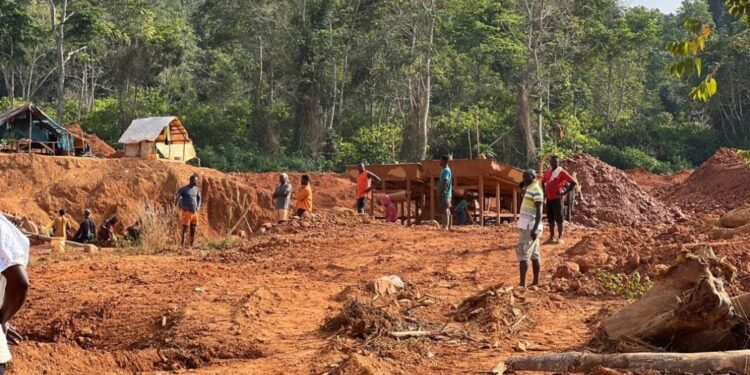Fresh Evidence of Illegal Mining Erodes Progress in Protecting Atiwa Forest Reserve
Images and videos have surfaced showing illegal mining activities at the boundary of the Atiwa Forest Reserve in Ghana’s Eastern Region, raising concerns about environmental degradation and the ongoing struggle to combat ‘galamsey.’
The footage reveals men actively mining and destroying portions of the protected forest reserve, a development that highlights the persistent threat posed by illegal mining to Ghana’s natural resources.
Galamsey’s Environmental and Economic Toll
Illegal mining, commonly known as ‘galamsey,’ is a significant contributor to deforestation, land degradation, and pollution of water bodies in Ghana. It has devastating effects on ecosystems, agriculture, and public health.
Earlier this year, Ghana’s water regulator issued a dire warning that the nation might need to import potable water within five years if galamsey along vital water bodies persists. Moreover, Ghana, the world’s second-largest cocoa producer, faces a dual threat as cocoa farms are often destroyed to make way for illegal mining sites, endangering a critical export commodity and the livelihoods of countless farmers.
Latest Incident Follows National Pledge
The illegal mining activities in the Atiwa Forest Reserve come just two weeks after six out of twelve presidential candidates in the December 7 elections signed a National Pledge Against Illegal and Irresponsible Mining. The pledge, spearheaded by the Ghana Coalition Against Galamsey (GCAG), aimed to galvanize commitment to ending galamsey and ensuring responsible mining practices.
Signatories of the pledge included President-elect John Mahama of the National Democratic Congress (NDC), Alan Kyerematen of the Movement for Change, Vice President Dr. Mahamudu Bawumia of the New Patriotic Party (NPP), Kofi Akpaloo of the Liberal Party of Ghana (LPG), Hassan Ayariga of the All-People’s Congress (APC), and independent candidate John Twum Barima.
Calls for Action
The recent galamsey activity at the Atiwa Forest underscores the urgent need for robust enforcement of environmental protection laws and increased community involvement to safeguard Ghana’s natural resources.
Environmental groups and stakeholders continue to call for a total ban on all forms of artisanal mining, emphasizing the long-term risks to the environment, water resources, and agricultural productivity.
As Ghana grapples with the environmental and economic consequences of galamsey, the latest incident serves as a reminder of the critical importance of coordinated efforts to address illegal mining and preserve the nation’s natural heritage.
Below are some images from the ongoing illegal mining at Atiwa Forest Reserve::





















